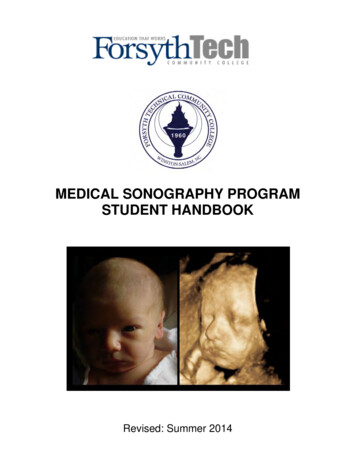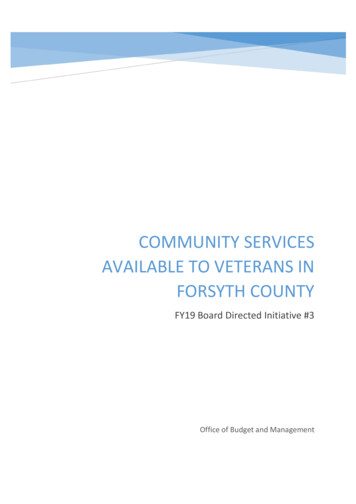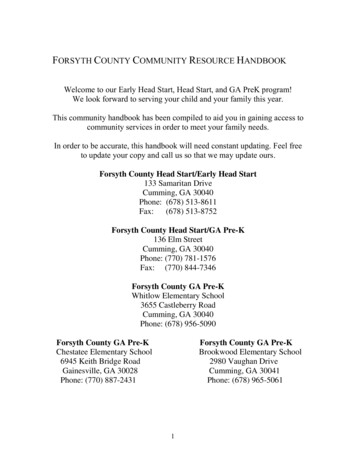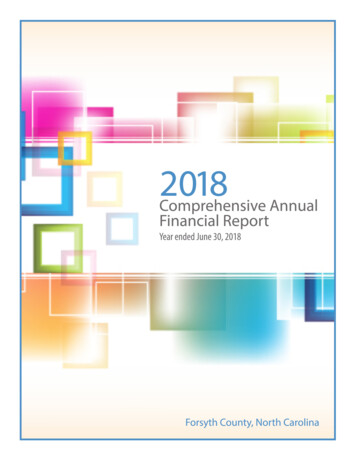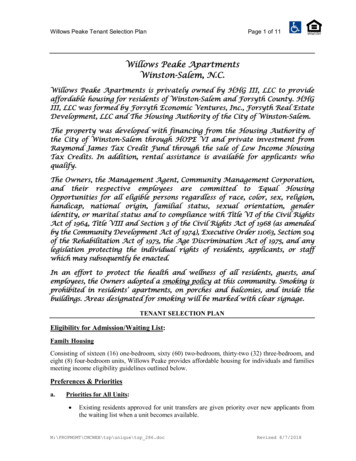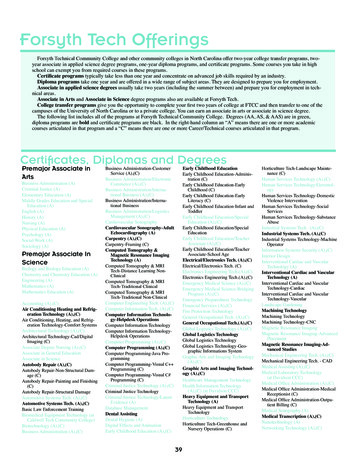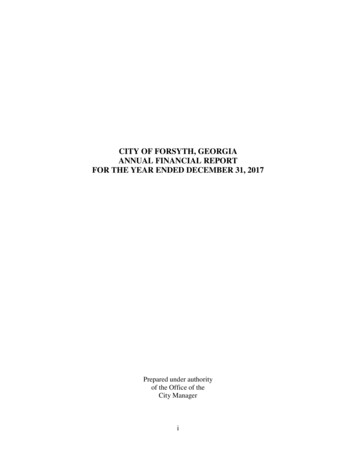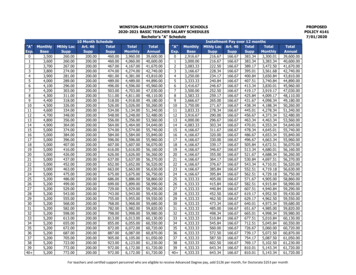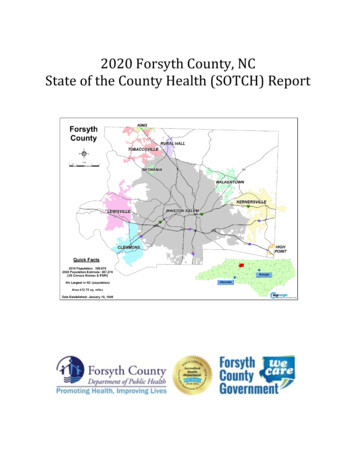
Transcription
2020 Forsyth County, NCState of the County Health (SOTCH) Report
2020 Forsyth County, NC SOTCH Report2Please direct comments or questions to:Forsyth County Department of Public HealthEpidemiology & Surveillance Unit799 N. Highland AvenueWinston-Salem, NC 27101336.703.3120 or 336.703.3146Suggested Citation:Forsyth County Department of Public Health, Epidemiology & Surveillance Unit.(2021). 2020 Forsyth County, State of the County Health (SOTCH) Report. ForsythCounty Department of Public Health. Winston-Salem, NC. [insert page numbers,tables, etc., if applicable]. Accessed [insert date].Forsyth County Department of Public HealthEpidemiology & Surveillance Unit
2020 Forsyth County, NC SOTCH Report3TABLE OF CONTENTSIntroduction .4Priority Health Issues . 4Progress Made in 2020Infant Mortality Reduction . .4Sexual Health .6Major Morbidity & Mortality Issues 8Morbidity 8Mental Health .8Cancer 9Mortality. . 10Emerging Issues . 11New Initiatives . .11Sources . 13Forsyth County Department of Public HealthEpidemiology & Surveillance Unit
2020 Forsyth County, NC SOTCH Report4IntroductionThe 2020 Forsyth County State of the County Health (SOTCH) Report provides an overview of changes inForsyth County’s population health since the 2019 SOTCH Report. Specifically, it provides an update oneach Community Health Improvement Plan (CHIP) that was implemented after the 2017 CommunityHealth Assessment (CHA). These CHIPs are aimed at reducing infant mortality, improving oral healthamong populations ages 0-5 years, and improving sexual health among populations ages 15-24 years.The 2020 SOTCH also informs the Forsyth community about major changes in mortality and morbidityfactors, and highlights emerging issues and new initiatives.CHIP I: Reduce Infant Mortality2020 UpdateObjective 1: Increase the multidisciplinary and multiagency composition of the coalition with 15additional members by 12/31/2019In 2019, this objective was partially achieved when 10 agencies/community groupsresponded positively and are now represented at Coalition meetings (2019 ForsythCounty SOTCH). In 2020, five (5) additional agencies/community groups becamemembers of the Coalition. Thus, this objective was met in 2020.Objective 2: Increase the percentage of members who attend bi-monthly meetings from 50% to75% or more by 12/31/2019This objective was met in 2019 (2019 Forsyth County SOTCH).Objective 3: Provide information on safe/unsafe sleep practices to parents and caregivers in zipcodes 27101 and 27105 because from 2014 to 2019, the majority of infants who died in ForsythCounty were born to families who lived in these zip codes (Appendix XX). To achieve thisobjective:i. By February 2020, recruit 10 Forsyth County pediatric providers who will agree to discusssafe/unsafe sleep with parents and caregivers of babies born in Forsyth County.This objective was achieved in January 2020.ii. By February 2020, recruit each of the 10 pediatric providers to distribute safe sleeppackage/bags to each family that visits their practice. The contents of each package/bagwill include safe sleep and SIDS prevention booklets, posters for the waiting areas, a onepage handout for parents/caregivers to help visualize what a safe sleep space looks like,and “do’s and don'ts” of ‘safe/unsafe’ sleep magnetsThis objective was achieved in February 2020.iii. By February 2020, prepare and deliver 40 packages of safe sleep booklets and othermaterials to each of the 10 providers.This objective was achieved in February 2020.Objective 4: By February 1, 2021, instruct all Novant Health, Women’s Services’ staff whoprovides service to pregnant women and their partners, as well as the parent(s) and caregiversof infants to discuss and distribute safe sleep materials at each visit.Forsyth County Department of Public HealthEpidemiology & Surveillance Unit
2020 Forsyth County, NC SOTCH Report5i. By February 1, 2020, Novant Health, Women’s Services, will email a directive to allpregnancy and pediatric care service providers to discuss safe sleep with clients at eachvisit, and to distribute safe/unsafe materials to each client.This objective was achieved in January, 2020.ii. By March 1, 2020, Novant Health, Women’s Services will distribute safe sleep materials toall pregnancy and pediatric care service providers for their distribution to clients at the endof each visit.This objective was achieved in February, 2020.Changes in the Data that Underpin the Infant Mortality Reduction CHIPThe reduction of Forsyth County’s infant mortality rate has been one of the Forsyth community’s majorgoals during the last 3 CHA cycles. Yet, Table 1 shows that Forsyth County’s 5-year rolling average infantmortality rate has remained relatively unchanged from 2011-2015 to 2014-2018, and increased from 8.2to 8.9 from 2014-2018 to 2015-2019. For the 5-year rolling average periods 2011-2015 to 2015-2019,Forsyth County’s infant mortality rate has ranked the highest or second highest among peer counties(Table 1). Forsyth County’s 5-year rolling average infant mortality rate has exceeded that of NorthCarolina’s from 2011-2015 to 2015-2019 (Table 1).Table 1. Trends in the 5-year Infant Mortality Rate for Forsyth, Peer Counties and NorthCarolina, 2011-2015 to 6.47.07.0GuilfordMecklenburgWakeNorth 5.67.27.96.05.97.2Forsyth County Department of Public Health, Epidemiology & Surveillance Unit, May 6, 2021Source: State Center for Health StatisticsTable 2 (page 6) shows that Forsyth County’s total infant deaths in 2019 was among the highest of thepast 5 years. Similar to previous years, the majority of infant deaths in 2019 were due to extremeimmaturity, prematurity, and/or congenital abnormalities (77.3%). During the upcoming CommunityHealth Assessment (CHA) cycle, the Forsyth County Infant Mortality Reduction Coalition (FCIMRC), theDepartment of Public Health’s Care Management for High-Risk Pregnancies (CMHRP) and Nurse FamilyPartnership (NFP) programs will work together to identify outreach programs and goals that could helpto reduce this infant health outcome.Forsyth County Department of Public HealthEpidemiology & Surveillance Unit
2020 Forsyth County, NC SOTCH Report6Table 2. Summary Characteristics of Infant Deaths for Forsyth County, NC 2015-2019*2019Infant s%Extreme immaturity, prematurity, &congenital .0%00.0%00.0%Sudden Infant Death00.0%13.0%49.1%00.0%13.1%Unsafe 36.8%00.0%00.0%00.0%00.0%Total infant yth County Department of Public Health, Epidemiology & Surveillance Unit, May 25, 2021Source: 2020 (2019 cases) Community Child Protection Team (CCPT)/Child Fatality Prevention Team (CFPT) Review* Total % could be off due to roundingCHIP II: Sexual Health (Chlamydia)2020 UpdateObjective 1: By July 2022, POSSE (Prevent Ongoing Spread of STIs Everywhere) will increase by20% the number of education sessions (including printed information materials) that areconducted in partnership with universities (Winston-Salem State University (WSSU), WakeForest University (WFU), Salem College, and University of North Carolina, School of the Arts(UNCSA)) to provide sexually transmitted infections’ (STI) education to students on campus.During 2017/2018, a total of 30 education sessions were held.i. To achieve this objective, two (2) education sessions per month will beconducted on each college campus from September to November, and Januaryto April of each academic year.Table 3 shows that this objective has not been met. Inadequate staffcontinues to negatively impact POSSE’s goal of achieving a 20% increase inSTI education sessions from a high of 30 sessions in the 2016/2017 schoolyear. Additionally, the COVID-19 pandemic prevented on campus educationsessions for March and April, 2020.Table 3. Number of STI Education Sessions Conducted at Salem College, UNCSA, WFU, andWSSU for the 2015/2016 to 2019/2020 School YearsSchool 15/2016Salem al1725343028Forsyth County Department of Public Health, Epidemiology & Surveillance Unit, February 20, 2020Source: Forsyth Couny Department of Public Health, Personal Health & Clinical Services, POSSE(Prevent Ongoing Spread of STIs Everywhere), May 14, 2021Forsyth County Department of Public HealthEpidemiology & Surveillance Unit
2020 Forsyth County, NC SOTCH Report7Objective 2: By June 2022, increase by 10% the number of high school students who participate inTeen POSSE.To achieve this objective, incentives were offered to students to get them toparticipate.Table 4 shows that this objective has not been met. Inadequate staff and theCOVID-19 pandemic prevented further outreach and follow-up with students.Table 4. Number of Winston-Salem/Forsyth County (WS/FC) High School Students whoParticipated in Teen POSSE, 2015/2016 to 2019/2020 School YearsSchool 72015/2016Boys24442Girls55666Total7910108Forsyth County Department of Public Health, Epidemiology & Surveillance Unit, February 20, 2020Source: Forsyth Couny Department of Public Health, Preventive & Health Education Services, TeenPOSSE (Prevent Ongoing Spread of STIs Everywhere), May 14, 2021Changes in the Data that Underpin the Sexual Health (Chlamydia) CHIPTable 5 shows that Forsyth County’s 2019 chlamydia rate of 844.6 is its highest of the past 5 years.However, although it exceeds the state’s average (679.3), it is lower than Durham’s (931.3), Guilford’s(999.9) and Mecklenburg’s (904.9).Table 5. Newly Diagnosed Chlamydia Annual Rates for Forsyth County, Peer Counties and North Carolina based on1Year of Diagnosis, rth 3.16,500595.16,093568.45,524526.94,967485.8Forsyth County Department of Public Health, Epidemiology & Surveillance Unit, May 24, 2021Source: 2019 North Carolina STD Surveillance Report. t.pdf Accesed May 24, 20211Rates are expressed per 100,000 population2020 data will be finalized after June 30, 2021Table 6 summarizes the number of new Forsyth County chlamydia cases from 2015 to 2019. Overall,there has been relatively very little change in the percentage of chlamydia cases among populations 24years of age from 2015 to 2019. It has consistently been between 65% and 68%. In 2019, populations 24 years of age accounted for 67% of Forsyth County’s newly diagnosed chlamydia cases. While thepercentage of new cases attributed to the age 24 population in 2019 (67%) has increased slightly fromForsyth County Department of Public HealthEpidemiology & Surveillance Unit
2020 Forsyth County, NC SOTCH Report8the previous year (65%), Table 6 shows that 70% of this younger group were females. This observation isconsistent with the percentage attributed to females in previous years among this group. Between 2015and 2019, females accounted for between 70% and 73% of the number of new chlamydia cases amongpopulations who were age 24 years.Table 6. New Chlamydia Cases for Poulations Age 24 Years or Younger, Forsyth County, NC, 2015-2019YearTotalAge 24 years, TotalAge 24 years, Females only# of cases# of cases% of total cases# of cases% of total age 24 years Forsyth County Department of Public Health, Epidemiology & Surveillance Unit, May 24, 2021Source: North Carolina Electronic Disease Surveillance System (NC EDSS). Current as of May 24, 20212020 data will be finalized after June 30, 2021Trends in Other Major Morbidity and Mortality FactorsMorbidityCancer, mental health, diabetes, cerebrovascular disease, hypertension, heart disease and chronic lowerrespiratory disease are just a few of the major health issues in Forsyth County. For this SOTCH Report, areview of the major morbidity factors is limited to cancer and mental health.CancerTable 7 shows that for 2015-2019, the 5-year rolling average incidence rate for cancer in Forsyth County(472.7) exceeded that of North Carolina’s (469.2). Except for Guilford (488.9), it was also higher thanDurham’s (460.3), Mecklenburg’s (460.9), and Wake (462.0) counties. Forsyth County’s 5-year rollingaverage incidence rate for cancer of the lung/bronchus (65.9) exceeded the state’s (62.8), and all peercounties (Table 7). However, its 5-year rolling average incidence rate for cancer of the prostate waslower than the state’s (116.9) and all peer counties.Table 7. Preliminary 2015-2019 Cancer Incidence Rates per 100,000 Population for Specific Sites, Forsyth, PeerCounties, and North CarolinaSite1ForsythN. CarolinaDurhamGuilfordMecklenburgWakeOverall 9.448.5Melanoma (Skin)21.525.520.927.522.225.8Female 127.7Forsyth County Department of Public Health, Epidemiology & Surveillance Unit, May 30, 2021Source: State Center for Health Statistics as of May 30, 20211Age-Adjusted to the 2000 US Standard Population CensusForsyth County Department of Public HealthEpidemiology & Surveillance Unit
2020 Forsyth County, NC SOTCH Report9Table 8 shows that Forsyth County’s projected total number of new cancer cases for 2021(2,295) is expected to be higher than each of the previous year’s. While cancer of thelung/bronchus is expected to remain unchanged (327) from the previous year, cancers of thecolon/rectum (171), female breast (419), and prostate (273) are projected to exceed theprevious year’s estimate of 169, 407 and 263, respectively.Table 8. Projected Number of New Cancer Cases for Forsyth County, NC, 2017-2021YearTotalColon/RectumFemale 6738631925920172,117164376315Forsyth County Department of Public Health, Epidemiology & Surveillance Unit, May 15, 2021Source: State Center for Health Statistics, May 15, 2021262Mental HealthMental health continues to be a health crisis for Forsyth County. Table 9 shows that the numberof residents who visited the Emergency Department (ED) for mental health reasons in 2020(2,318) declined from the previous year’s total (2,746). Nevertheless, the 2020 total isnoteworthy because for most of the year, Forsyth County’s EDs limited acceptance of nonCOVID related emergencies. Table 9 shows that the majority of residents who sought mentalhealth-related ED care were primarily male (56.0%), and based on race/ethnicity, White, nonHispanic/Latino (54.6%), and Black, non-Hispanic/Latino (35.7%).Table 9. Forsyth County, NC Residents who Expressed Suicide Ideation during Emergency Department Visits ,2016 – 2020*TotalMaleFemaleBlack, non-Hisp/LatinoHispanic/LatinoWhite, 0.3%3.3%Forsyth County Department of Public Health, Epidemiology & Surveillance Unit, April 21, 2021Source: North Carolina Disease Event Tracking and Epidemiologic Collection Tool (NC DETECT), Accessed April 21, 2021* Total % could be off due to roundingForsyth County Department of Public HealthEpidemiology & Surveillance Unit
2020 Forsyth County, NC SOTCH Report10MortalityChronic diseases and health conditions are the leading causes of death in Forsyth County. Figure 1shows that although the rate has decreased to 157.9 (2015-2019), cancer remains the number onecause of death in Forsyth County. While the death rate due to heart diseases has ranked second from2011-2015 (145.2) to 2015-2019 (147.0), it has been increasing. Similarly, the death rate due tounintentional injuries has increased from 31.8 (2011-2015) to 45.0 (2015- 2019).Figure 1. Trends in the Top Five Leading Causes of Death based on the 5-Year Roling Average Race-Specific andSex-Specific Age-Adjusted Death Rates, Forsyth County, NC, 2011-2015 to 2015-2019Rates per 100,000 PopulationStandard Year 2000 US .020.00.02011-2015Cancer: All sites174.9Heart Diseases145.2CLRD*47.6Unintent. D: Chronic Lower Respiratory DiseaseForsyth County Department of Public Health, Epidemiology & Surveillance Unit, May 28, 2021Source: State Center for Health Statistics, May 28, 2021Table 10 shows that Forsyth County’s death rate due to cancer was fairly similar to North Carolina’s buthigher than all peer counties. It’s death rate due to heart disease (147.0) was lower than NorthCarolina’s (157.3) but higher than all peer counties. Except for Mecklenburg’s death rate due tounintentional injuries (65.0), Forsyth County’s death rate due to chronic lower respiratory diseases,unintentional injuries, and cerebrovascular diseases were higher than all peer counties and NorthCarolina (Table 10).Table 10. The 2015-2019 5-year Rolling Average Race/Ethnicity-Specific and Sex-Specific Age-adjustedTop Five Leading Causes of Death in Forsyth County with Corresponding Data for Peer Counties andDiseasesForsythNorth CarolinaDurhamGuilfordMecklenburgCancer: All sites157.9158.0147.7153.3136.1Heart Diseases147.0157.3128.2136.4128.1Chronic Lower Resp Diseases45.344.026.622.430.0Unintentional Injuries45.039.331.441.865.0Cerebrovascular Diseases44.242.732.643.837.9Forsyth County Department of Public Health, Epidemiology & Surveillance Unit, May 27, 20211Standard 2000 US PopulationSource: State Center for Health Statistics, May 27, 2021Forsyth County Department of Public HealthWake134.6119.227.128.440.6Epidemiology & Surveillance Unit
2020 Forsyth County, NC SOTCH Report11Emerging IssuesPolysubstance overdose remains an emerging issue for Forsyth County. While it is not yet dominatinghealth discourse, public health practitioners should pay attention. Table 11 shows that during theCOVID-19 pandemic, 81 residents received service for polysubstance overdose at the County’sEmergency Departments. Although this number of residents is lower than previous years, this is a healthissue that requires immediate prevention/intervention planning because residents report taking notonly illegal drugs of interest but also, common products that are found in most households.Table 11. Emergency Department Visits due to Polysubstance Overdose (Overdose on 2 Drugs of Interest) for ForsythCounty, NC Residents, 2016–2020*2020Age2019# of Visits % of Total # of Visits 6 yrs33.7%7-17 yrs10 18 yrs68Total*812018% of Total # of Visits75.1%12.3%1884.0%113100.0%1382017% of Total # of Visits2016% of Total # of 0%195100.0%110% of %Forsyth County Department of Public Health, Epidemiology & Surveillance Unit, May 30, 2021Source: North Carolina Disease Event Tracking and Epidemiologic Collection Tool (NC DETECT)* Totals may be off due to roundingNew InitiativesBeginning in Summer 2021, the Forsyth County Women, Infants and Children (WIC) Program will beimplementing four (4) initiatives that aim to inform and improve access to its services.I.Employment of an Outreach Coordinator from July 1st, 2021, to June 30th, 2022.This position will focus on outreach and promotion of WIC’s services to daycares, OB/GYNoffices, food banks and food pantries by distributing information on a regular basis to theiroffices. WIC will finance the position.II.Improve Coordination and Collaboration of Services with Head StartHead Start provides comprehensive early childhood education, health, nutrition, and parentinvolvement services to low-income children and families in our county. All Head Start childrenare income eligible for WIC services. Both the WIC and Head Start programs offer nutritioneducation, and perform weight and height measurements as well as hemoglobin testing.Objective:i. To combine services, ideas and information that would better serve clientsii. Provide nutrition education, alternatelyTo achieve these goals, WIC’S assigned staff will be on site at Head Start on its studentregistration days. A memorandum of understanding (MOU) that will document the agreementbetween WIC and Head Start regarding the exchange of information such as measurements andadjunctive eligibility is pending. No additional funding is needed.III.WIC Certifications at Wake Forest Baptist Medical CenterWIC is awaiting Baptist Hospital’s approval to locate a WIC Team (consisting of one nutritionistand one office assistant) within the hospital. This agreement would allow WIC to certify newbabies and post-partum women before they depart the hospital. This agreement would allowForsyth County Department of Public HealthEpidemiology & Surveillance Unit
2020 Forsyth County, NC SOTCH Report12WIC to provide breast pumps for premature babies and order special formulas much faster thanwhat is currently experienced. In general, Moms of premature babies wait for discharge to go toa WIC office for support. WIC will provide funding for this team. The expected start date of thiscollaboration is between June 1 and July 31, 2021.Objectives:i. Reduce stress among new mothers by eliminating the burden of their visiting the WICoffice to register for service soon after birthii. Provide breast pumps to Moms of premature babies sooner than before. This shorterturnaround time will allow Moms to remain with their fragile babies while they are inNICU.IV.Wake Forest and WIC Collaborative Research ProjectPurpose:Study the possibility of Wake Forest/Baptist pediatricians’ ability to reduce sugary drinkconsumption (and promote more water consumption) in early childhood by partnering with theWIC program. This collaboration will focus on both improving connections between the ForsythCounty WIC office and pediatric practices at Wake Forest Baptist, and also will enhance theresources available to educate WIC families about healthy beverage choices.Funding:Robert Wood Johnson Foundation's Healthy Eating Research program.Forsyth County Department of Public HealthEpidemiology & Surveillance Unit
2020 Forsyth County, NC SOTCH Report13Sources2016 (2015 cases). Community Child Protection Team/Child Fatality Prevention Team (CCPT/CFPT)Review2017 (2016 cases). Community Child Protection Team/Child Fatality Prevention Team (CCPT/CFPT)Review2018 (2017 cases). Community Child Protection Team/Child Fatality Prevention Team (CCPT/CFPT)Review2019 (2018 cases). Community Child Protection Team/Child Fatality Prevention Team (CCPT/CFPT)Review2020 (2019 cases). Community Child Protection Team/Child Fatality Prevention Team (CCPT/CFPT)Review2019. NC DHHS, Division of Public Health, HIV/STD/Hepatitis Surveillance Unit2020. Infant Mortality, NC State Center for Health Statistics (NC SCHS)2020. North Carolina Disease Event Tracking and Epidemiologic Collection Tool (NC DETECT).2020. North Carolina Electronic Disease Surveillance System (NC EDSS).2020. NC State Center for Health Statistics (NC SCHS), Projected new cancer cases and deaths forselected sites by county.Forsyth County Department of Public HealthEpidemiology & Surveillance Unit
College 2019/2020 2018/2019 2017/2018 2016/2017 2015/2016 Source: Forsyth Couny Department of Public Health, Personal Health & Clinical Services, POSSE (Prevent Ongoing Spread of STIs Everywhere), May 14, 2021 Table 3. Number of STI Education Sessions Conducted at Salem College, UNCSA, WFU, and WSSU for the 2015/2016 to 2019/2020 School Years

